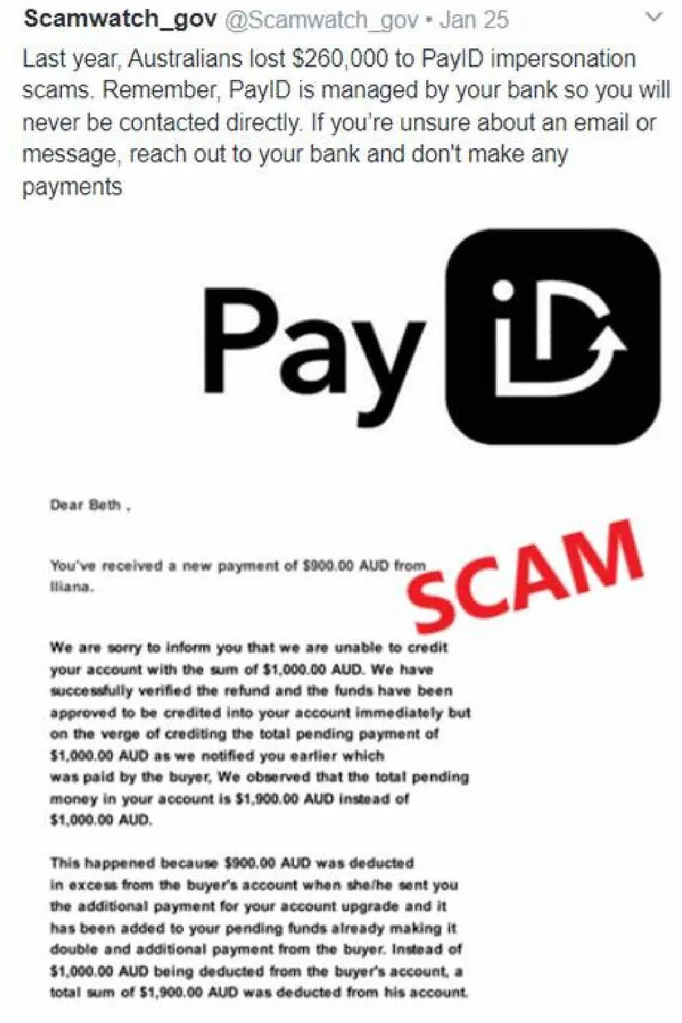Australians lost $2.74 billion to scams in 2023, and while the Australian Competition and Consumer Commission (ACCC) said that’s lower than the previous year, there are still some scams that are harder to spot than others.
The PayID scam that targets marketplace sellers could easily fall into that category, partly because it is so common.
If you’ve ever put your old couch, lamp or kettle up for sale online, then had a potential ‘buyer’ pushing you to use PayID, you’re not alone. It’s one of the first signs of the PayID scam that criminals use on sites like Facebook Marketplace and Gumtree.
It typically starts with a message from a supposed ‘buyer’ saying they want to use PayID to buy whatever you’re selling.
The messages can seem relatively normal at first. PayID is actually a legitimate payment method that uses a phone number, email address or ABN to send and receive money. But there is a risk these messages are actually part of a scam that uses fake PayID email accounts to trick you into sending money to scammers.
“These scammers often won’t haggle over the price and will state they will send someone to pick up the goods without viewing them,” a spokesperson from the Australian Competition and Consumer Commission (ACCC) has told marie claire Australia.
“They ask to pay by PayID and shortly after providing their PayID details, the seller receives [an] email indicating an overpayment which needs to be repaid before they can receive the payment.”

The email, which can look convincingly real, is actually fake, as are the scammer’s claims that they will “reimburse” you for any money that leaves your account.
While many of us presume that we can spot a scam from a mile away, these PayID scams are not always obvious. Scamwatch reported in February 2023 that Australians had lost $260,000 to PayID impersonation scams in the previous year. While there’s no recent data specifically for PayID scams, Australians lost over $15.8 million through buying or selling scams between January and July 2024, according to Scamwatch’s Scam Statistics data.
So, how can you avoid falling victim to a PayID scam? We asked an expert to find out.

How To Spot A PayID Scam
The best way to avoid falling for a PayID scam is to gain a better understanding of what PayID actually is.
PayID was launched in 2018 but is still newer than most other payment methods. So, people tend to be less familiar with the payment process and are more likely to fall for a scammer’s claims.
According to the ACCC, “PayID allows consumers and businesses to use their mobile number, email address, ABN or Organisation Identifier to receive fast, secure payments.”
The ACCC also notes that PayID is usually a secure payment method “because you don’t provide your account details to the purchaser.”
When it comes to a PayID scam, the biggest red flag to be aware of is any emails, text messages or phone calls claiming to be someone from PayID.
“PayID is managed by your bank and you will never receive communication from PayID directly,” explains the ACCC.
The ACCC also says that alarm bells should ring if your marketplace buyer claims that a “relative” will come to pick up the item.
“Be wary of anyone who is willing to pay the maximum price and/or requesting a third party collection without viewing a high value item for sales,” the ACCC warns.
Most importantly, remember to be wary of any buyers asking you for a payment. You should never have to send money to receive money.
How To Tell If A Marketplace Buyer Is Legitimate
One of the first signs that a potential buyer might be a scammer is if they don’t ask about the condition of the item you’re selling. Especially if it’s an expensive item, not asking to view it first is a warning sign, according to Scamwatch.
Another way to check if a buyer is legit is to go to their profile. What details are public? Can you tell how long they’ve had a profile? If you’re selling through a group as well as Marketplace, check how long they’ve been part of the group. It’s not definitive but it can help determine if the person is who they say they are.
You can also ask if they’re willing to make the payment in a different way, such as by direct transfer or cash (if it’s a pick-up sale). There are plenty of other legitimate ways to make a payment, which makes insisting on PayID suspicious.
What Should I Do If I Have Been The Victim Of A PayID Scam?
Falling for a PayID scam can happen to anyone. If you think you might have been scammed, the ACCC recommends taking the following actions.
- Contact your bank or financial institution as soon as possible.
- Contact the platform on which you were scammed, and inform them of the circumstances surrounding the scam.
- The ACCC encourages you to make a report on the Scamwatch website. You can also follow @scamwatch_gov on Twitter/X and subscribe to Scamwatch radar alerts.
- Tell your friends and family. It helps to share your experience, they can offer support and you can help protect them from scams.
Can I Get Money Back From PayID?
Unfortunately, getting money back after you have made a PayID transfer is difficult and may not be possible. This is because the payments are almost instant and managed by each individual bank. That’s why it’s important to contact your bank straight away. They may be able to request a reversal through the receiving bank or give you more guidance.
This article originally appeared on Marie Claire Australia and is republished here with permission.







